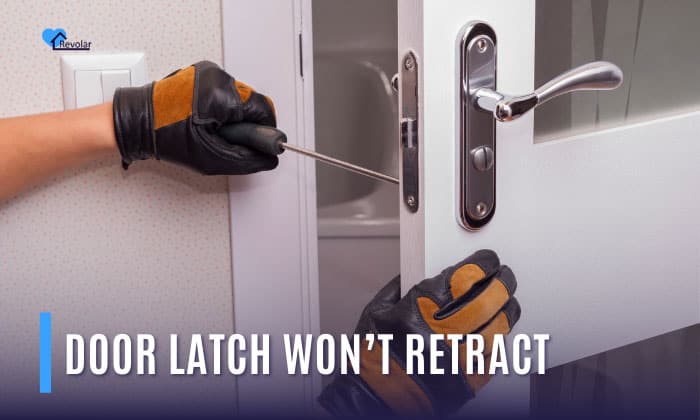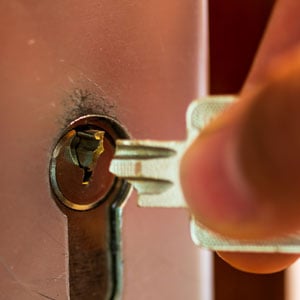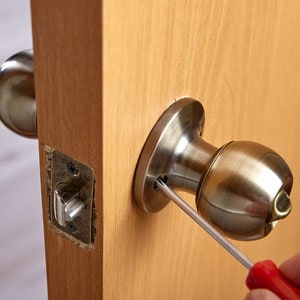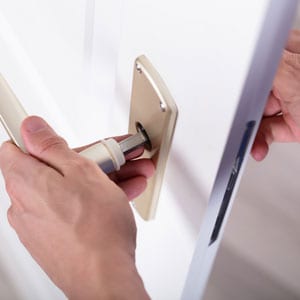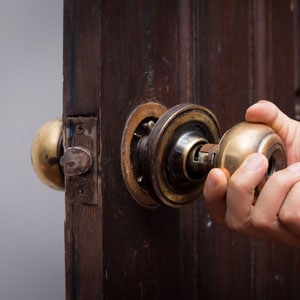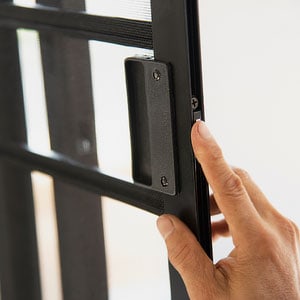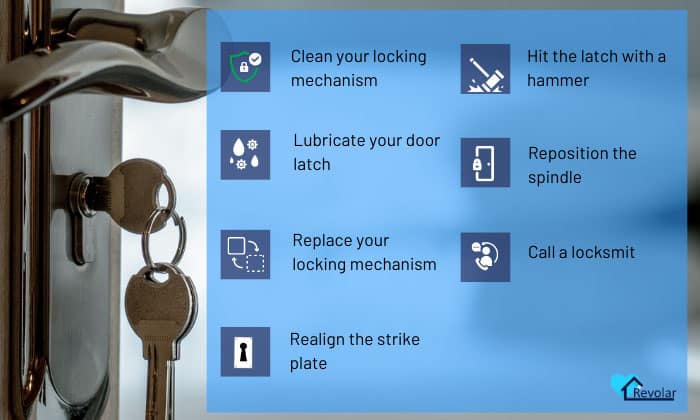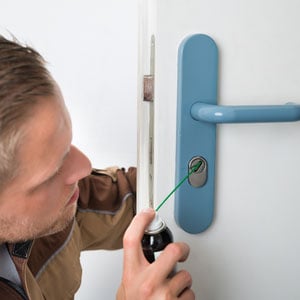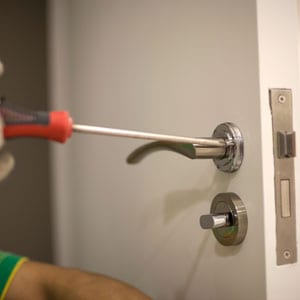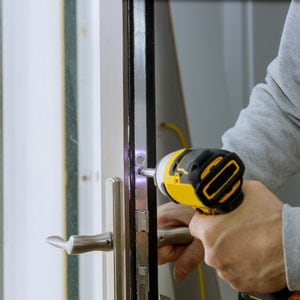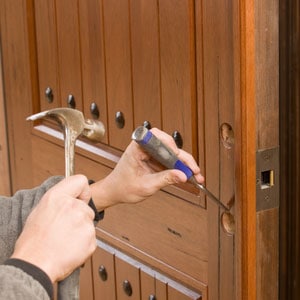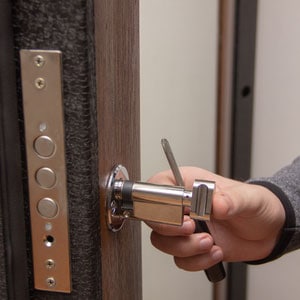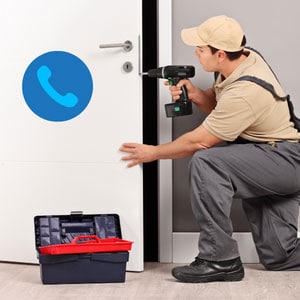Usually, when a doorknob or handle is turned, the door handle latch retracts back to the lock in order for the door to be opened. When closing, the latch goes into the strike plate and stays there unless the door knob or handle is moved.
However, when a latch won’t fully retract, it will be impossible for you to get into your home. Fortunately, I will show you the causes of why your door latch won’t retract and how to fix it.
Table of Contents
Why Won’t My Door Lock Retract?
If your storm door latch won’t retract, it can be attributed to certain variables, such as the age of your door lock, the weather, and lock type that you have. The following are the five reasons why your door latch won’t retract completely:
1. Your locking mechanism is broken.
The two sides of door knobs are connected through a metal rod called a spindle. The spindle relaxes and retracts the latch when the door knob is turned.
However, if you have a broken or faulty spindle, the internal door handle latch will not react even though your door knob can be perfectly turned. If the spindle is perfectly okay, but the latch still won’t withdraw, the problem might be rooting from the door knob or latch mechanism.
Parts that may need replacement include the spring, pins, or bushings. These issues are a common occurrence on locks, whether you have a Schlage door latch or one from another brand.
2. Your door latch is jammed.
When you both have a door latch not extending fully and door latch not springing back, the problem might be because of a jammed door latch. To check if you have a jammed latch, turn the door knob clockwise and counterclockwise.
Due to the passing of time, your UPVC door latch can become sticky and lose its innate lubrication. A Kwikset latch may also be jammed due to rust buildup and frequent contact with water.
3. Your strike plate is misaligned.
If you have a strike plate that is poorly installed, it might be why your door latch won’t retract fully. The strike plate might be too low, too high, or too far from its correct position on the door frame, which is why your door knob won’t retract.
The culprit can also be the moisture that is accumulated within the door, making the door a bit bigger, which in turn misaligns the strike plate.
4. There is accumulated dirt.
When there is accumulated dirt on your door latch, it might be stopping the component from retracting all the way. This can usually happen in doors that are exposed to rain and dust.
The same problem may also happen to a car door latch, though broken fobs or lock parts may also be the cause of the malfunction.
5. Door frame or door hole is misaligned.
If your door latch won’t go back to the door when you turn the knob, the door hole or edge bore might be causing the problem, perhaps due to incorrect installation or age-related misalignment between the latch and the hole.
What Are the Solutions?
Based on the confirmed cause of why your door latch stuck in retracted position or not retracting, choose and follow the best option that is right for you.
Here are some of the things you can do to fix a door latch that won’t retract:
1. Clean your locking mechanism.
If you suspect dirt and dust accumulating inside your lockset, remove it from the door. This way, you can properly clean the nooks and crannies of your lock.
Make sure that every part of your lockset is thoroughly cleaned and dried so that you can put them back properly. Use water or a mixture of water and soap with a clean cloth for this process.
2. Lubricate your door latch.
Fix a sticking door latch by applying a lubricant on it. The lubricant will smoothen any friction that your latch might encounter when it retracts.
Try to avoid petroleum-based lubricants, since they can accumulate dirt and dust that will worsen the movement of the lock. Always use dry-graphite or silicone-based lubricants.
3. Replace your locking mechanism.
If your latch is already beyond repair, your last resort is to replace it with a new one. A new lock will help you avoid problems that might occur if you continue to use a broken lock.
Remember to buy a new set that is similar to your old lockset so that you won’t have to do any major adjustments to your door for easy installation.
4. Realign the strike plate.
Realigning the strike plate is not easy, and it might take you time to do it depending on how severe the misalignment is. To realign the strike plate, follow these steps:
- Measure the misalignment. This will tell you how high, low, or far your strike plate is to make adjusting easier.
- Unscrew the fittings from the strike plate. Take your screwdriver and remove the screws from it.
- Realign the strike plate. Depending on the misalignment, adjust your strike plate until it realigns with the door jamb.
- Test if the alignment is correct. Open and close your door to ensure that the latch retracts when opened and stays on the door jamb when closed.
- Adjust the screws then tighten those on your strike plate to finalize the repair.
5. Hit the latch with a hammer.
For a quick, temporary fix, simply hit the latch with a hammer to withdraw it. This method should suffice if you want the door to work temporarily until you can examine it in detail later.
6. Reposition the spindle.
Align the spindle with the door latch. The spindle should be half-way into the lock hubs, with neither side being pushed deeper than the other.
7. Call a locksmith.
If you have done everything and nothing seems to work, you might have to hire a professional. Your trusty locksmith can find out the root cause of the problem and solve it.
Depending on the issue, the cost of hiring a locksmith can range from 75 dollars to 250 dollars. That is why you have to make sure that you have done what you can before calling a professional.
Read more:
Conclusion
Security should always be paired with convenience to create a safe and stress-free home environment for your family. Identify potential security risks and inconvenience and solve them before they get out of hand.
Knowing why your door latch won’t retract will not only improve the safety of your home or office, but it will also keep you from being locked out of your room. Save money from hiring a locksmith and do the dirty work on your own.

I am the last member to join Revolar and might be just the luckiest to work with dedicated people like Teddy and John. Our team has established a process where my only job is writing the best content to deliver incredible ideas and guides.


